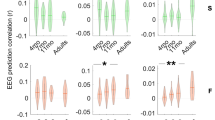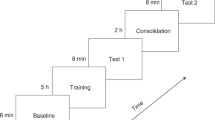Abstract
THE remarkable linguistic abilities of human neonates are well documented1–5. Young infants can discriminate phonemes even if they are not used in their native language2–4, an ability which regresses during the first year of life4,5. This ability to discriminate is often studied by repeating a stimulus for several minutes until some behavioural response of the infant habituates, and later examining whether the response recovers when the stimulus is changed6. This method, however, does not reveal how fast infants can detect phonetic changes, nor what brain mechanisms are involved. We describe here high-density recordings of event-related potentials in three-month-old infants listening to syllables whose first consonants differed in place of articulation. Two processing stages, corresponding to an increasingly refined analysis of the auditory input, were identified and localised to the temporal lobes. A late frontal response to novelty was also observed. The infant brain recognizes a phonetic change in less than 400 ms.
This is a preview of subscription content, access via your institution
Access options
Subscribe to this journal
Receive 51 print issues and online access
$199.00 per year
only $3.90 per issue
Buy this article
- Purchase on Springer Link
- Instant access to full article PDF
Prices may be subject to local taxes which are calculated during checkout
Similar content being viewed by others
References
Eimas, P. D., Siqueland, E. R., Jusczyk, P. W. & Vigorito, J. Science 171, 303–306 (1971).
Best, C. T., McRoberts, G. W. & Nomathemba, M. S. J. exp. Psych. hum. Percept. Perform. 13, 345–360 (1988).
Eimas, P. D., Miller, J. L. & Jusczyk, P. W. in Categorical Perception (ed. Harnad, S.) 161–188 (Cambridge Univ. Press, New York, 1987).
Werker, J. F. & Tees, R. C. Infant Behav. Dev. 7, 49–63 (1984).
Kuhl, P. K., Williams, K. A., Lacerda, F., Stevens, K. N. & Lindblom, B. Science 255, 606–608 (1992).
Jusczyk, P. W. in Measurement of Audition and Vision in the First Year of Postnatal Life: A Methodological Overview (eds Gottlieb, G. & Krasnegor, N. A.) 195–222 (Ablex, Norwood, NJ, 1985).
Tucker D. Electroenceph. clin. Neurophysiol. 87, 154–163 (1993).
Woods, D. L. & Elmasian, R. Electroenceph. clin. Neurophysiol. 66, 447–459 (1986).
Näätänen, R. & Gaillard, A. W. K. in Tutorials in Event-related Potential Research: Endogenous Component (eds Gaillard, A. W. K. & Ritter, W.) 119–142 (North-Holland, Amsterdam, 1983).
Näätänen, R. Behav. Brain Sci. 13, 201–288 (1990).
Novak, G. P., Kurtzberg, D., Kreuzer, J. A. & Vaughan, H. G. Jr Electroenceph. clin. Neurophysiol. 73, 295–305 (1989).
Scherg, M. & Berg, P. BESA: Brain Electrical Source Analysis Handbook (Max-Planck Institute for Psychiatry, Munich, 1990).
Witelson, S. F. & Pallie, W. Brain 96, 641–646 (1973).
Chi, J. G., Dolling, E. C. & Gilles, F. H. Ann. Neurol. 1, 86–93 (1977).
LeMay, M. in Cerebral Dominance (ed Geschwind, N. & Galaburda, A. M.) 26–42 (Harvard Univ. Press, Cambridge, MA, 1984).
Bertoncini, J. et al. Brain Lang. 37, 591–605 (1989).
Vargha-Khadem, F. & Corballis, M. Brain Lang. 8, 1–9 (1979).
Best, C. T., Hoffman, H. & Glanville, B. B. Percep. Psychophys. 31, 75–85 (1982).
Molfese, D. L. & Burger-Judisch, L. M. in Cerebral Laterality: Theory and Research (ed. Kitterle, F. L.) 71–102 (Erlbaum, Hillsdale, NJ, 1991).
Courchesne, E. in Tutorials in Event-related Potential Research: Endogenous Component (eds Gaillard, A. W. K. & Ritter, W.) 329–344 (North-Holland, Amsterdam, 1983).
Kurtzberg, D., Stapells, D. R. & Wallace, I. F. in Identification of Infants with Developmental Disabilities (eds Vietze, P. M. & Vaughan, H. G.) 160–180 (Allyn & Bacon, New York, 1988).
Mills, D. L., Coffey-Corina, S. A. & Neville, H. J. J. Cogn. Neurosci. 5, 317–334 (1993).
Nelson, C. A. & deRegnier, R. Devl Neuropsychol. 8, 119–134 (1992).
Rothbart, M. K., Posner, M. I. & Boylan, A. in The Development of Attention: Research and Theory (ed. Enns, J. T.) 47–66 (Elsevier North-Holland, Amsterdam 1990).
Perrin, F., Pernier, J., Bertrand, D. & Echallier, J. F. Electroenceph. clin. Neurophysiol. 72, 184–187 (1989).
Author information
Authors and Affiliations
Rights and permissions
About this article
Cite this article
Dehaene-Lambertz, G., Dehaene, S. Speed and cerebral correlates of syllable discrimination in infants. Nature 370, 292–295 (1994). https://doi.org/10.1038/370292a0
Received:
Accepted:
Issue Date:
DOI: https://doi.org/10.1038/370292a0
This article is cited by
-
EEG repetition and change detection responses in infancy predict adaptive functioning in preschool age: a longitudinal study
Scientific Reports (2023)
-
Face specific neural anticipatory activity in infants 4 and 9 months old
Scientific Reports (2022)
-
Severe respiratory disease caused by human respiratory syncytial virus impairs language learning during early infancy
Scientific Reports (2020)
-
Evoked and oscillatory EEG activity differentiates language discrimination in young monolingual and bilingual infants
Scientific Reports (2018)
-
Early asymmetric inter-hemispheric transfer in the auditory network: insights from infants with corpus callosum agenesis
Brain Structure and Function (2018)
Comments
By submitting a comment you agree to abide by our Terms and Community Guidelines. If you find something abusive or that does not comply with our terms or guidelines please flag it as inappropriate.



